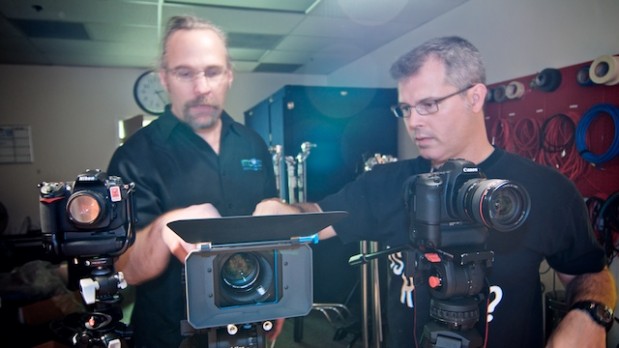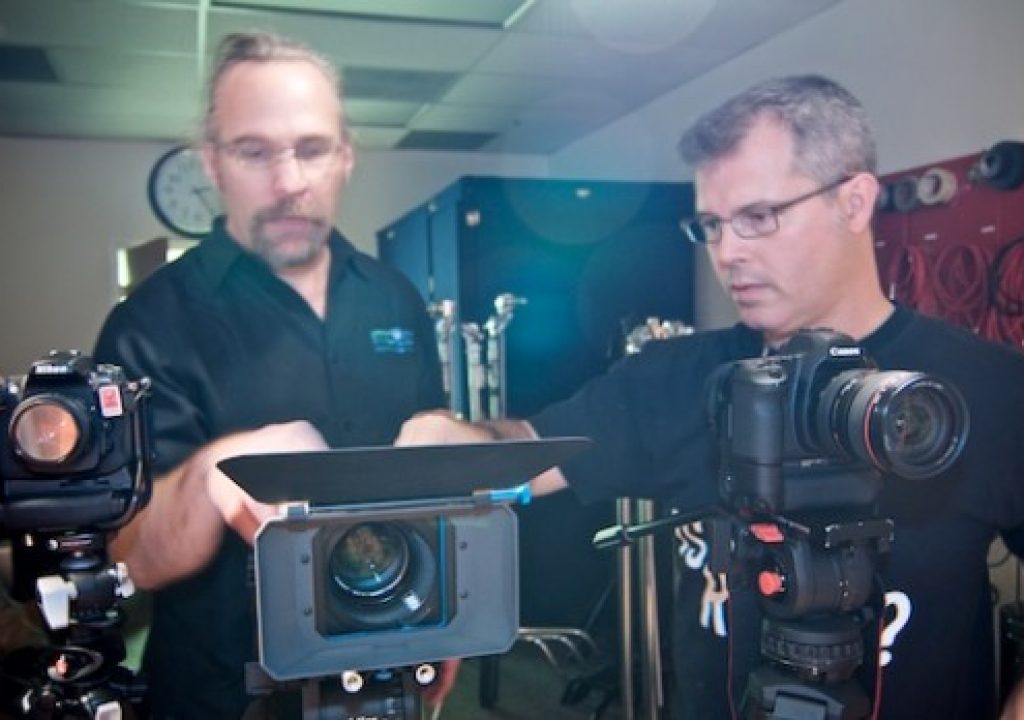
DPs Jim Ball and Matt Gottshalk set the cameras for our studio test. Lenses and camera settings were matched as closely as possible.
I am truly excited by the convergence of technology that is occurring with DSLR cameras and video recording. The format allows for the recording of some truly amazing images due to sensor size and lens selection. But like all technologies, it suffers from some constraints that need to be overcome.
What I have to share today is some head-to-head footage tests between popular camera models from Nikon, Canon, and Red. I also have a few select shots from the music video project that nicely illustrate what’s possible with these medium. I offer up some footage and photos from our recent shoots in order to help you form your own opinions about what’s possible. This is not a formal camera test, rather an exploration of a new medium. Let’s gp!
The Studio Test
Emmanuel Etim places a Kino Flo light on set
Our first three footage tests are people. We shot these in our studio in order to test skin tones under ideal lighting conditions. We kept the backdrop quite simple and chose to shoot into a white cyc in order to focus solely on the subjects. Our intention was to test the Canon 5D Mark II, Canon 7D, and Nikon D300S in a head-to-head manner. I’ll first present the tests, then offer some analysis at the end of each section. Please note, the cameras were set to auto white balance, which resulted in differences between cameras. These differences in white balance are easily changeable in post production.
Test One – Black Woman
Our first subject was a black woman with minimal lighting. We only used two lights for this first setup
- KinoFlo Four bank light through a white diffuser
- 650 W Arri Fresnel light into a bounce for a hair light
This is the original footage, re-sized for the web with no color correction or tonal adjustments, using the auto white balance in the cameras. (Click through on Facebook link to see HD video).
Test Two – Asian Man
Our second subject was an Asian man with additional lighting. We only used four lights for this second setup.
- KinoFlo Four bank light through a white diffuser
- Kino Flo Two bank light through a white diffuser as a backlight
- 650 W Arri Fresnel light into a bounce for a hair light
- 650 W Arri Fresnel light with barn doors to add to the edge
Again, this is the orginal footage, re-sized for the web with no color correction or tonal adjustments.
Test Three – White Woman
Our third subject was an white female. We used the same setup as above, but made minor adjustments to the lights for exposure. Here is the re-sized, but unprocessed footage for your review.
The Studio Test: Conclusions
Ignoring the white balance between the Nikon and Canon cameras, all three shots are acceptable. The Canon 5D stands out nicely due largely to its bigger sensor. We found that the 5D handled subtleties in the shadows much better than the other two cameras. Under controlled lighting however, we found that all three cameras performed adequately. It is important to keep in mind that the Nikon camera only shoos 720P and uses a noisier MJPEG video codec.
NOTE – The videos are viewable in HD here. http://www.facebook.com/video/?id=171237909754
Now let’s take a look at some less controlled lighting…
The Low Light Test
Our next round of tests focused on very low lighting levels and high contrast. We did this test because part of the upcoming project involved shooting concert footage in a dark club with high contrast lighting. We purposefully made this test difficult. We placed two bright practical lights near our subject, but left her sitting in the shadows.
Again, the only light in the scene is from practical lighting instruments, which we purposefully left harsh with lots of spill. Our goal was to simulate concert lighting conditions and really evaluate the heartiness of our three cameras.
Low Light Test: Conclusions
The Canon 5D Mark II is a clear winner due to its larger sensor, which improves its low-light sensitivity and therefore reduces the amount of noise present under these conditions. The Nikon D300S and Canon 7D both show noise, with the Nikon being the worst offender. In defense of all three cameras, there’s not a video camera on the market that would come out looking very well under these poor lighting conditions. This test was a brutal one, and the goal was to see how well the cameras did at very high ISO settings. We shot these scenes at 1600 under very poor lighting.
With these tests complete, next let’s take a look at the mighty Red One and how it stacks up against the Canon 5D Mark II:
The Red One Test
In a test that we’ve wanted to try for a long time, we put the Canon 5D Mark II up against a Red One. These shots were recorded back to back on location.
The 5D shot was grabbed in-between takes on a live set, so we couldn’t match angles. (Again, for the purists, we did not bring a Red and a 5D into the field at the same time to test them, we were just on a shoot with both).
- The Red One shot using a Nikon Prime lens – 85mm lens
- The Canon 5D Mark II was used a 50mm prime lens
Red versus 5D Shootout: Conclusions
The Red One is a great camera, but the 5D is no slouch either. The Red One offers two key benefits over the 5D. First is the ability to shoot up to 4K video. If you can “get by” with 1080p however, then this extra resolution might not be a deal breaker.
The other area is Raw video, the Red has much greater flexibility for color correction; the 5D (and its brethren) tend to provide you with already-compressed 8-bit files which don’t leave a lot of latitude for correction in post (see other articles on how to eek more latitude out of the 5D). The video clips here were not subjected to post-processing, and were both compressed for web delivery; as a result they compare well to each other. When we viewed both on studio grade monitors in 1080p, the results were also indistinguishable.
In short: The Red is a nice option (if you can afford it), but I can tell you it much more likely that I’ll be shooting my next PSA spot with a 5D.
With the tests complete, let’s take a look at a few shots from the field and see how the DSLR cameras perform.
Real World Performance
We’re working on a music video for the very talented musician Luke Brindley. The entire process includes concert clips, an Electronic Press Kit and a music video. We’re documenting the whole procedure in great depth for a full length book and DVD to be released in early 2010. What I offer up here are three shots that for me, really show how great these cameras are.
Lens Selection
Here we shot with a Lensbaby Composer lens. This allows for the lens to be bent as well as have the aperture changed. The nice effect is a variable depth of field effect. Not bad for about $350.
Depth of Field
There’s something magical about how great depth of field is with these cameras. Here we shoot just a few inches away from our subject using only a shiny board to fill in the scene. We used a short 28mm lens and opened the camera all the way up.
Follow Focus
We found the cameras easy to pull tough focus, with the right gear. In order to achieve smooth focus, we needed a large enough image in to view and more precise controls. The folks at Zacuto came through on both fronts. We already owned their Z-finder, and we borrowed a follow focus to put it through its paces.
- Z-Finder: The Zacuto Z-Finder enlarges the image on the back of the camera so you can actual see essential details (like focus). The eyecup also blocks out unwanted light so you can make accurate judgment about exposure.
- Z-Focus: The Z-Focus and Zip Gear bands allowed us to convert our lenses to a follow focus system. This allowed for precise control and smooth transitions between focus points.
More to Come…
There’s a lot more to this exciting genre. We’re deep into exploration and I’ll share more soon. Feel free to leave comments and requests for more footage and information. We’ve also got a Facebook group about the book where we’ll start sharing excerpts and more test footage in the coming months.
Special thanks to Matt Gottshalk for his assistance with this article.

